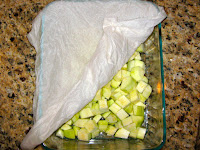This has been a year of change for us and we've really just begun. I've got a lot of other projects under way to make our lives greener and more efficient, and I'll blog about those as we tackle them.
Here are ten ways we've become more environmentally conscious so far:
1. As our light bulbs burn out, we've started replacing them with more energy efficient ones. They last longer and use less energy.
2. I now clean our home with
homemade cleaning supplies and machine-washable cloth towels, not paper towels.
3. I buy green versions of the household products that I don't make myself (such as garbage bags, bathroom tissue, facial tissues, paper napkins, paper towels, laundry detergent, dish soap, dishwasher detergent). The labels don't just feature nebulous words such as "green", "non-toxic", or "environmentally-friendly". Rather, the words I look for are "recycled" (at least 30%), organic, biodegradable, or sustainable.
4. I give things away rather than throwing them away. I could go on and on about this. We all sometimes itch to push the ejector button on certain things in our homes - maybe old plastic tubs, clothes, shoes, that old wagon-wheel table, or old baby toys. Before you haul it out to the curb, ask around to see if someone wants it, post it on
freecycle.org or
craigslist, give it to
Goodwill. Your castoffs could be treasures for someone else! Seriously. You will be surprised.
5. No more bottled water. As I
previously blogged, we had our tap water tested, confirmed it's safe to drink (as best as we can) and stopped buying bottled water.
6. I am more careful about planning our meals and food purchases to minimize tossing out spoiled food.
7. I use reusable shopping bags whenever I remember to bring them. When I don't bring them, I opt for plastic bags and use them to dispose of dirty diapers later.
8. My older child is now old enough to understand conservation, so I've started reinforcing this with the kids. We turn off lights when we leave a room, don't run the tap while we're busy brushing our teeth, eat what is on our plates. This last point is an important one. I've started explaining about those in the world who often go to bed with empty stomachs. It is disrespectful to these people to waste the food we are so fortunate to have.
9. We are more careful about recycling - particularly our
curbside recycling, which represents the majority of our recycling opportunity. But we are also now more careful about finding ways to recycle items that should not or cannot be picked up curbside.
10. We've lined our attic with radiant barrier foil to save on our electric bill. I will write more about this later. I'll just say that we did it last summer and are now reaping the benefits.
Must go now. The older child has just convinced the toddler that he is missing a toe. I hear some shrieking.













































![Validate my Atom 1.0 feed [Valid Atom 1.0]](valid-atom.png)